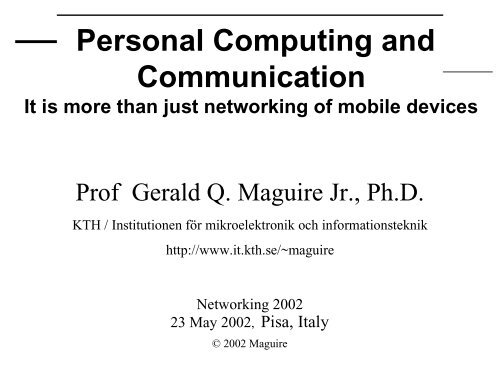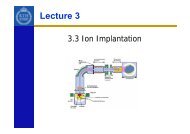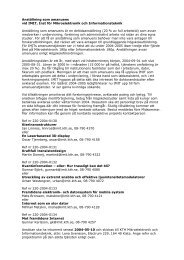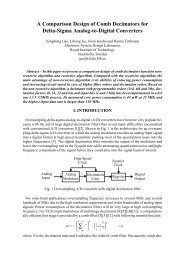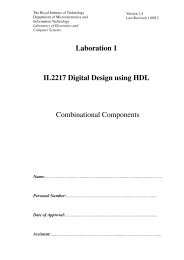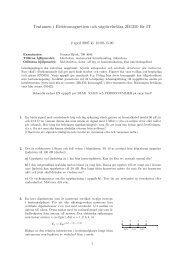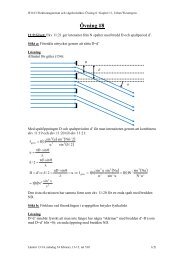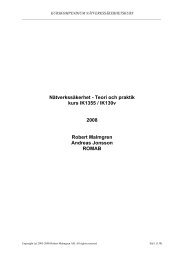Personal Computing and Communication: It is more than just ...
Personal Computing and Communication: It is more than just ...
Personal Computing and Communication: It is more than just ...
Create successful ePaper yourself
Turn your PDF publications into a flip-book with our unique Google optimized e-Paper software.
<strong>Personal</strong> <strong>Computing</strong> <strong>and</strong><br />
<strong>Communication</strong><br />
<strong>It</strong> <strong>is</strong> <strong>more</strong> <strong>than</strong> <strong>just</strong> networking of mobile devices<br />
Prof Gerald Q. Maguire Jr., Ph.D.<br />
KTH / Institutionen för mikroelektronik och informationsteknik<br />
http://www.it.kth.se/~maguire<br />
Networking 2002<br />
23 May 2002, P<strong>is</strong>a, <strong>It</strong>aly<br />
© 2002 Maguire
Bottlenecks<br />
• Server <strong>and</strong> Network B<strong>and</strong>width <strong>and</strong> latency<br />
Server<br />
...<br />
Server<br />
Picocell<br />
Microcell<br />
Macrocell<br />
Femtocell<br />
• User B<strong>and</strong>width <strong>and</strong> latency<br />
Server Gateway to wireless network<br />
<strong>Personal</strong> device<br />
Backbone<br />
Gbit/sec<br />
•Power <strong>and</strong> Energy O(energy)<br />
•Imagination!<br />
Wireless<br />
kbit/s..Mbit/s<br />
User
Future Systems<br />
2005-2015 - very high level of integration
Remote Hapatics, Remote Control, ...<br />
Server<br />
local<br />
robot<br />
Internet<br />
ANN<br />
remote<br />
robot<br />
“Real-time prediction of h<strong>and</strong> trajectory by ensembles of cortical neurons in<br />
primates” , J. Wessberg, C. R. Stambaugh, J. D. Kralik, P. D. Beck, M. Laubach,<br />
J. K. Chapin, J. Kim, S. J. Biggs, M. A. Srinivasan, <strong>and</strong> M. A. L. Nicolel<strong>is</strong>,<br />
NATURE, v408, 16 Nov. 2000 pp. 361-366.<br />
Up to 96 50-µm diameter microwires implanted in different cortical areas<br />
see also Tom Clarke, “Here come the Ratbots: Desire drives remote-controlled<br />
rodents”, Nature, 2 May 2002 <strong>and</strong> S. K. Talwar, et al. “Rat navigation guided<br />
by remote control.” , Nature, 417, 37 - 38, (2002).
1989 - Student Electronic Notebook Project<br />
(IBM Research <strong>and</strong> Columbia University)<br />
Notebook computer with “paperlike” (stylus) input + DS-SS radio<br />
D. Duchamp, S. Feiner, <strong>and</strong> G. Q. Maguire, Jr. Software Technology for Wireless Mobile <strong>Computing</strong>.<br />
IEEE Network. 5(6):12-18, November, 1991<br />
talk “Student Electronic Notebook”, Swed<strong>is</strong>h Institute of Computer Science,<br />
Nässlingen, Sweden,17 August 1990.<br />
Partial support from NSF Grant ECD-88-11111 to Center for Telecommunications<br />
Research, Columbia University.
Student Electronic Notebook (SEN) Project<br />
~20 Notebook computers with “paperlike” (stylus) input + ARLAN<br />
230kbps DS-SS radio (in 902-928MHz ISM b<strong>and</strong>) + flex circuit<br />
interconnects. Built upon an IBM PS/2 model 55 motherboard + PS/2 to<br />
ISA bus interface (for radio <strong>and</strong> LCD controller); 50 minute battery life<br />
Running d<strong>is</strong>kless AIX (a UNIX variant), X11, Andrew Windowing<br />
system, NFS, … first version of Mobile*IP.<br />
J. Ioannid<strong>is</strong>, G. Q. Maguire Jr., I. Ben-Shaul, M. Levedopoulos, <strong>and</strong> M. Liu. Porting AIX<br />
onto the Student Electronic Notebook. 1991 ACM Conference on <strong>Personal</strong> <strong>and</strong> Small<br />
Computers, pages 76-82. Association for <strong>Computing</strong> Machinery, June, 1991.<br />
NC State Univ. also had the same notebooks, but chose to use serial interface <strong>and</strong> make<br />
custom applications rather <strong>than</strong> use UNIX + X11. In the same amount of time they had<br />
3 applications, we had all of the Andrew tools, UNIX applications, <strong>and</strong> several books<br />
-- all working via a popup keyboard!
Student Electronic Notebook: Traffic<br />
Researchers at IBM Research wanted “traffic models” from the group at<br />
Columbia University<br />
z Initial models were based on desktop applications<br />
These initial models were wrong!<br />
z<br />
Mobile users switch tasks <strong>more</strong> often<br />
z Mobile users have many <strong>more</strong> tasks running in parallel<br />
z Very high correlation across users - due to social correlations<br />
(for example, course start times, professor saying “As you can see in figure XXX” <strong>and</strong><br />
everyone wants figure XXX, …<br />
limited battery life ⇒<br />
(a) Multicast wireless booting of 1Mbyte OS + 1 Mbyte of initial<br />
file system.<br />
J. Ioannid<strong>is</strong> <strong>and</strong> G. Q. Maguire Jr. The Coherent File D<strong>is</strong>tribution Protocol, RFC 1235,<br />
Network Working Group, June, 1991.<br />
(b) D<strong>is</strong>cussion of “anticipatory” file system<br />
Carl Tait, Hui Lei, Swamp Acharya, Henry Chang Intelligent File hoarding for Mobile<br />
Computers, MOBICOM 1995
Correlation (Lots of open problems)<br />
z Very high correlation across users - due to social<br />
correlations<br />
(e.g., course start times, professor saying “As you can<br />
see in figure XXX” <strong>and</strong> everyone wants figure XXX,<br />
… , limited battery life<br />
z Multicasting induces correlation across streams (as<br />
observed by Don Towsley, University of Massachusetts,<br />
Amherst<br />
z “ Network Tomography through End-to-End Multicast<br />
Measurements”, BU/NSF Workshop on Internet Measurement,<br />
Instrumentation <strong>and</strong> Characterization, Boston University, Boston,<br />
Massachusetts, August 30, 1999 )<br />
z note that he exploits th<strong>is</strong> in h<strong>is</strong> MINC (Multicast Inference of Network<br />
Character<strong>is</strong>tics) technique: http://www-net.cs.umass.edu/minc/
Wearable(s)<br />
June, 1995
WLAN in 2002<br />
z IEEE 801.11b @ 11Mbps going to 23 Mbps ⇒ 802.11g<br />
z IEEE 801.11a @ 54 Mbps ⇒ IEEE 802.11h<br />
zSingle mode 802.11b radio chips at < US$10<br />
z 802.11b built-in to: laptops, PDAs, MP3 players, ...
Ultrawideb<strong>and</strong> (UWB)<br />
zUS FCC gave regulatory approval 14 February<br />
2002<br />
zIntel recently demo'd transmitter <strong>and</strong> receiver at<br />
100Mbps<br />
zIntel expects to be able to get 500Mbps at a few<br />
meters dropping to 10Mbps at 10m.
Martin Cooper’s Law<br />
Wireless b<strong>and</strong>width has effectively doubled every 2.5 years<br />
since Guglielmo Marconi received h<strong>is</strong> first wireless<br />
telegraphy patent in 1896 (>100 years ago). Th<strong>is</strong> same<br />
pace of innovation will continue for the next 100 years.<br />
⇒ 2009 > 100 Mbps 10 8 bps<br />
2016 > 1 Gbps 10 9 bps<br />
2041 > 1 Tbps 10 12 bps<br />
2066 > 1 Pbps 10 15 bps<br />
2091 > 1 Ebps 10 18 bps
Beyond single radios<br />
• Multiple radios<br />
• multiple b<strong>and</strong>s GSM 900/1800/1900<br />
• multiple radio st<strong>and</strong>ards<br />
• W-CDMA + GSM<br />
• WLAN +GSM/GPRS<br />
• Multiple receivers - for enhanced h<strong>and</strong>off<br />
⇒ Theo Kanter’s π* (π∉1∧π<br />
• Software defined radios - one radio which <strong>is</strong> <strong>just</strong> right (now)<br />
• Cognitive radios<br />
• planning <strong>and</strong> negotiating to determine what it should be<br />
•Joe Mitola III’s d<strong>is</strong>sertation (http://www.it.kth.se/~jmitola)
Heterogeneous Wireless Packet Networks<br />
0DFURFHOO *356<br />
+RWVSRWV :/$1<br />
0LFURFHOO *356<br />
5RDG+LJKZD\<br />
+RWVSRW :/$1<br />
0RELOH<br />
:/$1<br />
+RWVSRWV :/$1<br />
Adampted from<br />
T. Kanter
Doesn’t Mobile IP provide the answer<br />
z First mobile version of IP protocol developed by John Ionannid<strong>is</strong><br />
in 1989; one of two approaches at SIGCOMM’91<br />
z Mobile IP defined by RFCs 2002 .. RFC 2006 (Fall 1996)<br />
Mobile IP: Design Principles <strong>and</strong> Practices Mobile IP: The Internet Unplugged<br />
Charles Perkins (January 15, 1998) James D. Solomon (January 15, 1998)<br />
Objectives of Mobile-IP<br />
z Provide mobility support across changes in IP subnet<br />
z Support change in node location without changing IP address<br />
z <strong>Communication</strong> should be possible while moving<br />
z TCP/IP connections & Active TCP/UDP port bindings should<br />
survive the movement<br />
problems: Mobile IP hides location & mobility!
Situational awareness <strong>and</strong> Adaptability<br />
Where am I What am I Who am I<br />
Where am I going When will I be there<br />
What should I become<br />
Who should I become
Mobile keeps as king: Are we there yet<br />
Being able to l<strong>is</strong>ten for the next access point<br />
or new infrastructure <strong>is</strong> very powerful:<br />
z can reduce h<strong>and</strong>over times<br />
z can reduce power usage (since you can use a low power<br />
link <strong>just</strong> as soon as it <strong>is</strong> available)<br />
z dynamically assigned channels - useful for bursting data<br />
to a device (these could be orthogonal to the resources<br />
used in the cell) - consider for example use of a shorted<br />
(or longer) spreading code in a CDMA system<br />
⇒ Multiple receivers (<strong>more</strong> open problems)
Toward human-centric systems<br />
Computer - human interaction <strong>is</strong> currently focused on the computer<br />
(computer-centric)<br />
z Currently computers know little about their environment<br />
z Where are we<br />
z Who <strong>is</strong> using me<br />
z Is the user still there<br />
But there <strong>is</strong> evolving environment/context awareness<br />
z Give computers senses via sensors<br />
z Environment/context<br />
z User identity <strong>and</strong> presence<br />
You will wear your own personal user interface<br />
z interface can be cons<strong>is</strong>tent across all appliances<br />
z not because each appliance supports the interface, but because the<br />
user’s own interface provides cons<strong>is</strong>tency<br />
z Make the human the focus of the computer’s interaction
Badge Prototype <strong>and</strong> Badge 1 (Spring 1997)
Badge3 (1998) - front <strong>and</strong> back<br />
• 206MHz StrongARM<br />
• Audio in/out<br />
• LCD driver<br />
• 2 x temperature<br />
• 2 x humidity<br />
• light level<br />
• 3-ax<strong>is</strong> Accelerometer<br />
• PC Card slot<br />
• IrDA<br />
• 2 serial<br />
• JTAG<br />
• 1MB FLASH<br />
• 1 MB SRAM<br />
• full processor/memory interface on headers
Badge4 (2001) - front <strong>and</strong> back<br />
• 206MHz Intel SA1110 processor <strong>and</strong> SA1111 coprocessor<br />
• CD qualityAudio in/out<br />
• LCD driver<br />
• 2 x temperature<br />
• 2 x humidity<br />
• light level<br />
• 3-ax<strong>is</strong> Accelerometer<br />
• PC Card slot<br />
• IrDA<br />
• 2 serial<br />
• USB (master)<br />
• JTAG<br />
• 4MB FLASH<br />
• 2MB SRAM<br />
• SO-DIMM slot<br />
(PC100 SDRAM 64MB shown)<br />
• Compact FLASH interface on header
HP + Swatch = webwatch<br />
"The watch <strong>is</strong> an ideal way to stay connected to the Net because everyone<br />
has one <strong>and</strong> wears it willingly."<br />
"You put it on in the morning <strong>and</strong> go about your business with no<br />
concerns."<br />
“Because these devices are so smart <strong>and</strong> personalized, they're easy to use.<br />
"No pointing, clicking, dragging, dropping, connecting or configuring. <strong>It</strong> <strong>just</strong><br />
works." -- Mark T. Smith, 15 Jan. 1999<br />
Current Design (2002)<br />
In Future<br />
ƒ D<strong>is</strong>play System - supports multi-media<br />
More sensors<br />
ƒ 32 bit processor<br />
ƒ<br />
ƒ memory file system<br />
Motion, biometric…<br />
ƒ wireless network<br />
Security<br />
ƒ audio: speaker, microphone<br />
ƒ encryption<br />
ƒ Multithreaded OS<br />
ƒ wr<strong>is</strong>t b<strong>and</strong><br />
ƒ<br />
ƒ Peer web connectivity<br />
secure co-processor<br />
ƒ XML/HTTP/TCP/IP<br />
ƒ smart/SIM card<br />
ƒ MPEG-2 to MPEG-4 transcoding (in transform domain)
From Secure Ids ⇒ Device personalization<br />
Authenticate the user<br />
<strong>Personal</strong>ize the device automatically<br />
Consider a hotel without a check-in/out desk!
Camera/Scanner + Connectivity<br />
computed by:<br />
http://www.milk.com/ barcode/<br />
User agent can get details at http://051000029522.upc.org or<br />
http://029522.051000.upc.org {hypothetical domains}<br />
Returning “item.manufacturer” for further lookups: dietary<br />
information, recipies, check with the fridge, …<br />
For example: www.airclic.com returns:<br />
“You have entered, Campbells Pork And Beans in Tomato Sauce 16 oz Can …”
Intranet Telephone System:<br />
Symbol Technologies’ NetV<strong>is</strong>ion ® Data Phone<br />
z WLAN<br />
z HTML browser<br />
z VOIP “phone”<br />
z bar code reader<br />
⇒ Telia’s HomeRun<br />
⇒ bas<strong>is</strong> for subscription<br />
broadb<strong>and</strong> wireless voice<br />
<strong>and</strong> data
Direct URLs<br />
Directly emit a URL<br />
• direct to a page<br />
• indirectly via a redirector<br />
(ala SIP) - allowing per<br />
user, time dependant, …<br />
mappings<br />
V1<br />
V2<br />
HP’s CoolTown Beacon
f(User, context {location, URL, … })<br />
⇒ new URL<br />
Use SIP like redirectors to remap based on user, location,<br />
context, … ⇒ highly personalized <strong>and</strong> adaptive<br />
information<br />
T. Kanter’s Open System Architecture + explicit Mobile<br />
Service Knowledge ⇒ Adaptive <strong>Personal</strong> Mobile<br />
<strong>Communication</strong> (http://www.it.kth.se/~theo)<br />
HP’s Websign<br />
sensors (location + orientation) +<br />
wireless communication (e.g., WLAN) +<br />
algorithms<br />
⇒ enable an augmented reality device<br />
Example<br />
a PDA can automatically acquire new services using virtual<br />
CoolTown beacons relative to the user’s position
<strong>Personal</strong> Entertainment/Info/…<br />
the declining importance of synchrony<br />
<strong>Personal</strong><strong>is</strong>ed data: text, picture, audio, ads, ... play l<strong>is</strong>ts<br />
burst download in hotspots (WLAN) …<br />
Faster<br />
faster <strong>than</strong> “real-time” (DAB/DSS/… + GPRS) …<br />
download in the background (GPRS)<br />
Slower<br />
Theo Kanter, Per Lindtorp, Chr<strong>is</strong>tian Olrog, <strong>and</strong> Gerald Q. Maguire Jr.,<br />
“Smart Delivery of Multimedia Content for Wireless Applications”,<br />
MWCN’2000, Par<strong>is</strong>, May 2000<br />
See also http://www.slimdevices.com/products/slimp3/<br />
an ethernet attached MP3 player which gets bursts of content to play
Digital amplifiers <strong>and</strong> SIP speakers<br />
z Digital amplifiers now very efficient <strong>and</strong> low cost - with 100W<br />
or <strong>more</strong> power per channel (with 5, 7, … <strong>more</strong> channels).<br />
z Each channel has full power<br />
z SIP + IP + digital amp + speaker = full dynamic home theater<br />
which can follow you as you move about<br />
⇒ Multi-Device & Multi-Session<br />
<strong>Communication</strong><br />
increasingly important for “Smart Spaces”
But first you have to<br />
d<strong>is</strong>cover what <strong>is</strong> where!<br />
You may need to learn what are the frequencies,<br />
modulation, coding, etc. of the access points <strong>and</strong> other<br />
devices in your environment.<br />
If searching - Make them easy to find<br />
z Solve the equations of LPD, LPI, LPE in the reverse!<br />
z LPD - Low Probability of Detection<br />
z LPE - Low Probability of Exploitation<br />
z LPI - Low Probability of Intercept
<strong>Personal</strong> information space<br />
Where are my {<br />
What <strong>is</strong> the state of my {<br />
friends<br />
employees<br />
pets<br />
socks<br />
.<br />
.<br />
.<br />
<br />
⇒Connected Application Spaces - <strong>more</strong> <strong>than</strong> <strong>just</strong> a Smart Space<br />
Some initial projects:<br />
•Adaptive <strong>Personal</strong> Mobile <strong>Communication</strong> <strong>and</strong> Hottown - Theo Kanter<br />
•Cooltown <strong>and</strong> Social Media - HP Labs, Palo Alto California
From one h<strong>and</strong>set suits all to <br />
• Roll your own - from what you carry<br />
• Synthesizing the system you want from many<br />
appliances/accessories you carry/wear<br />
• later: the walls really do have ears<br />
• Synthesizing the system you want from the many<br />
appliances/accessories/sensors/actuators around<br />
you (perhaps even using Smart Dust)
<strong>Communication</strong>s <strong>and</strong> Privacy<br />
• Encryption essential - Onetime pads feasible<br />
• Identity hiding<br />
•Authentication when you mutually want to<br />
•Anonymous network access<br />
• Location hiding<br />
•Alberto Escudero-Pascual, www.it.kth.se/~aep<br />
“Anonymous <strong>and</strong> Untraceable <strong>Communication</strong>s - Location privacy in mobile<br />
internetworking”, Licentiate Thes<strong>is</strong>, KTH/IMIT, June 2001<br />
• Unlinkability between the location of wireless users <strong>and</strong> their activities<br />
• extension to Zero Knowledge Systems’s pseudonymous IPv4 network.<br />
• supports modification to the graph of anonymizers, thus supports mobility<br />
• Location m<strong>is</strong>-direction ⇒ End of Sovereignty<br />
• Traffic pattern hiding<br />
• Traffic hiding
Badge <strong>Communication</strong>s Model<br />
Badges are IP devices, they communicate via network attached access points.
Encryption as the norm<br />
zSince all the speech <strong>and</strong> other media<br />
content will be in digital form, it will be trivial<br />
to provide encryption <strong>and</strong> authentication of<br />
all communication<br />
z“public telephony” will be viewed as less<br />
secure <strong>than</strong> VPNs
Applications<br />
zLocation Aware<br />
zContext Aware<br />
zAdaptive <strong>Personal</strong>ization<br />
zExtending the individual<br />
z extending the user's senses <strong>and</strong> knowledge (mixed reality)<br />
z Hive/cooperative applications (games/entertainment/news/...)
Even <strong>more</strong> sensors<br />
Temperature<br />
Humidity<br />
Barometric pressure<br />
Light level<br />
Solar radiation<br />
Weight<br />
Acceleration<br />
...<br />
• D<strong>is</strong>tributed Weather data collection<br />
• Environmental monitoring<br />
• Energy <strong>and</strong> building management<br />
(HVAC)<br />
• Intelligent appliances<br />
• Automated customer care<br />
• Augmented Reality<br />
• ...
Scaling up<br />
z Large sites have hundreds of access points <strong>and</strong><br />
z thous<strong>and</strong>s of mobiles<br />
But th<strong>is</strong> <strong>is</strong> only a start!<br />
Emergence of Wireless Internet Service Providers (WISPs)<br />
z Formal operators<br />
z Telia’s HomeRun, <strong>Personal</strong>Telco, or Seattle Wireless, …<br />
z Informal associations<br />
z Electrosmog - http://www.elektrosmog.nu/<br />
z Global Access Wireless Database (GAWD) -<br />
http://www.shmoo.com/gawd<br />
Emergence of Brokers providing settlement services between<br />
WISPs.
Internet42 extended with WLAN<br />
11 Mbps 802.11b<br />
100 Mbps<br />
Switched<br />
Ethernet<br />
1Gbps<br />
Internet42<br />
Ethernet
New Viewpoint<br />
z Forget spectrum availability as the problem<br />
z Forget limited b<strong>and</strong>width as the problem<br />
z Forget error rate as the problem<br />
z Problem: Finding the trade off between available<br />
high quality b<strong>and</strong>width <strong>and</strong> the cost of the<br />
infrastructure, i.e., if cells shrink (thus increasing<br />
capacity, available b<strong>and</strong>width, decreasing error<br />
rate, …), then infrastructure cost increases, or <strong>is</strong><br />
there another way
Current WLAN Access Points<br />
LAN<br />
• B 1 <strong>and</strong> B 2 may be the same memory<br />
• B 3 <strong>and</strong> B 4 may be the same memory<br />
• B 5 <strong>and</strong> B 6 may be the same memory<br />
WLAN<br />
B 6<br />
B B 1 3<br />
S 1<br />
B 2<br />
B 4<br />
S 2<br />
S 5<br />
S 3<br />
S 4<br />
B 5<br />
Unfortunately S1, S2, S3, S4, <strong>and</strong> S5 are often a single µP.
1996-1999 MEDIA - very low cost basestations<br />
Ericsson Radio Systems AB, Tampere University of Technology (TUT),<br />
GMD FOKUS (GMD), Techn<strong>is</strong>che Universität Braunschweig (UBR),<br />
Interuniversity Microelectronics Centre (IMEC), <strong>and</strong> KTH.<br />
z SDL implementation of 802.11<br />
z Partitioning out much of the MAC’s functionality (i.e., the<br />
access point only needs to have the per packet processing --<br />
all else can be done remotely -- including some buffering!)<br />
zperhaps the access point does not even need a processor!
Future home/office/…<br />
network accesspoints
Who <strong>is</strong> going to install these<br />
network access points<br />
Getting home gateways into place may occur for the<br />
following reasons:<br />
1. Energy management -- as California <strong>and</strong> other places<br />
become third world countries - saving power will be<br />
very important<br />
2. Insurance - detecting leaks, … can save your<br />
insurance company lots of money - so they may pay for<br />
the installation<br />
3. Serving as my home agent, repository for my mobile<br />
agents, being virtually located (probably at some tax<br />
advantaged location!), ...
What are the connectivity expectations<br />
z Ubiquity <strong>is</strong> wrong<br />
z Model for communication vs. transactions (the<br />
transactor model)<br />
or Why TCP <strong>is</strong>n’t so important!<br />
z Role of re-intermediation (Delegation)<br />
z introduction of proxies to do service enhancements<br />
z Delegating things to agents
Example: PDA to IP Phone<br />
Avaya 4606 IP Telephony<br />
http://www1.avaya.com/enterpr<strong>is</strong>e/photo_library/photos/plipc88_lo.jpg
PDA via IP Phone to server ⇒<br />
(1) IP phones as access points<br />
Internet or Intranet<br />
Server<br />
Avaya 4606 IP Telephony<br />
http://www1.avaya.com/enterpr<strong>is</strong>e/photo_library/photos/plipc88_lo.jpg
(2) Changing from providing a remote<br />
Console to providing Service(s)<br />
Goal <strong>is</strong> to deliver a service to the user:<br />
z change from simply remoting the buttons/knobs/…<br />
z to delivering a service to the user<br />
If I'm l<strong>is</strong>tening to audio content <strong>and</strong> walk from one<br />
room to another, the goal <strong>is</strong> not to give me a<br />
remote control that lets me find <strong>and</strong> control a radio<br />
in th<strong>is</strong> new room - but rather the audio should be<br />
delivered by the appropriate means to where I<br />
am.
Former trends<br />
z Lots of asymmetric network links such as ADSL<br />
<strong>and</strong> cable modems<br />
z increasing use of firewalls - others have open<br />
networks which I can down load from, but my<br />
network <strong>is</strong> one-way<br />
z use of dynamic IP address - my machines only<br />
need an address when I want to download<br />
something<br />
z use of Network Address Translation (NAT) - you<br />
can’t see inside my network <strong>and</strong> I only need<br />
addresses when I’m downloading<br />
z user’s system <strong>is</strong> only a “client”
Increasingly Peer-to-Peer<br />
z My computers each need addresses all of the time<br />
z others get content from me<br />
z others can not only put data on my machines, but in many<br />
cases I don’t even know (or care) what the data <strong>is</strong> {in fact,<br />
I’d <strong>just</strong> as soon not know} - data sharing<br />
Napster/Gnutella/ICQ/Morpheus, KazAa, …<br />
z don’t need a firewall - I want others to use my machines -<br />
since they also let me use their machines (does th<strong>is</strong> lead to<br />
the Metcalf law for peers, value <strong>is</strong> proportional to the peers 2 )<br />
z user systems are clients <strong>and</strong> servers<br />
z (<strong>more</strong> general) Resource sharing - for example CPU<br />
sharing (SETI@HOME -- ~25 Teraflops of computing)<br />
z Service Sharing - rather <strong>than</strong> raw cycle or d<strong>is</strong>k blocks, the servers<br />
now make higher level services available - a user does not have to know<br />
where the service <strong>is</strong> - it simply <strong>is</strong> <strong>and</strong> hence <strong>is</strong> available
IPv6<br />
z Important transition<br />
z facilitate peer-to-peer<br />
z reduce costs <strong>and</strong> efforts for configuration of<br />
user’s machines (plug <strong>and</strong> serve)<br />
z importance of ANYCAST addressing<br />
But it <strong>is</strong> not arriving fast enough!
New network interface functions<br />
To exploit correlation<br />
zNeed: anticipatory network interface (with<br />
caching)<br />
To avoid problems with h<strong>and</strong>over between<br />
devices (see Mattias Ronqu<strong>is</strong>t, “Wireless<br />
Transport Layer Performance”, M.Sc.<br />
Thes<strong>is</strong>, KTH, 1999)<br />
zNeed an API to tell the interface to forget<br />
sending packets already enqueued in the<br />
device’s output queue<br />
zNeed an API to tell the network layer to<br />
immediately resend unacknowledged<br />
packets via the new interface
S ummary<br />
z <strong>Personal</strong>ized, adaptive, … everything<br />
z Ubiquity <strong>is</strong> wrong aim - NOT “anywhere & anytime”,<br />
but rather what I expect - where I expect it<br />
z Increasingly heterogeneous, but open architectures<br />
exploiting IP over every link<br />
z Decreasing need for synchrony<br />
z Exploiting bursts + dribble<br />
z Increasingly Transactions vs. <strong>Communication</strong><br />
z Role of re-intermediation (Delegation)<br />
z Multimode radios (perhaps even SDR) coming onto<br />
the market at low cost<br />
z Increasing correlation in traffic<br />
⇒ Lots of new research problems
¿Questions


